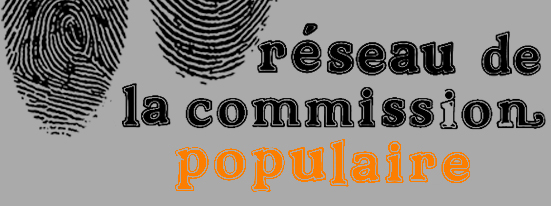Forum populaire du Réseau de la commission populaire
Promo forum
Écoutez la promo du forum.
Implausible Denial: CSIS In The Labour Movement
Implausible Denial: CSIS In The Labour Movement
When a cascade of scandals lead to the replacement of the RCMP Security Service with CSIS in the early ‘80s, government figures issued countless assurances that civilian oversight and a mandate restricting CSIS from targeting organizations engaged in lawful dissent would prevent the "excesses" plaguing the 1970s.
The RCMP had illegally bugged, raided, burglarized, collected files on and opened the mail of labour activists and the trade unions they belonged to. Leaders such as Grace Hartmann of CUPE, activists in CUPW and officials of Quebec’s Common Front were among the many trade union victims of a National Security project run amok. Because it was caught—repeatedly and publicly--the RCMP had to be seen to pay a price.
Yet despite the denials of politicians and the Security Intelligence Review Committee (SIRC), events in the intervening years illustrate that CSIS has maintained a lead-hand role in the business of keeping a close eye on, and agents within, the labour movement. It should be no surprise that CSIS has inherited this secretive mantle, as national security projects have focused on unions and workers since before the creation of the RCMP in 1920. Cold war obsessions with “subversives” and “Reds”, and the almost infinitely elastic boundaries of what constitutes “national security”, ensured this tradition of spying on unions would continue.
In fact, the “restricted” CSIS mandate turned out to be less prohibitory than claimed. “Lawful advocacy, protest or dissent” is declared out-of-bounds except when occurring “in conjunction” with in-bounds threats, including “activities…in support of…serious violence…for the purpose of achieving a political objective within Canada” 1. Alan Borovoy, former General Counsel to the Canadian Civil Liberties Association once noted this has given rise to the contorted argument that the mandate allows for targeting activists engaged in currently lawful activity which could support violence in the future. As well, although spying under the Act is limited to targeted individuals in unions, not unions themselves, “it is hard for snooping to avoid those who have ongoing relations with the targets”, thus expanding the surveillance web. 2
Such inventive linguistic gymnastics have played a big role in CSIS (and SIRC) denials that the agency has violated its mandate by spying on unions, but equally important has been its cloak of secrecy—the primary ingredient of cover-up.
Labour Encounters the Agency
It didn’t take long for the claims CSIS had shunned the old targeting habits to begin to wear thin.
In 1985, the B.C. Provincial Council of Carpenters discovered that a CSIS agent attended a meeting of members plotting strategy to unseat a group of progressive executive officers. It isn’t known what information or advice was forthcoming from the operative, but it is a certainty the Carpenters Union never received an acceptable explanation. Solicitor-General Perrin Beatty dismissed the incident by claiming that the contact was “voluntary” on the part of the union members, that CSIS had committed “no improprieties” and had “no interest in legitimate union activities”. Bill Zander, Council President, stated two years after the unanswered complaint, “If they have a stake in a local election we’d like to know what the hell it is”. 3
A more widely publicized event was the exposure in 1987 of Marc-Andre Boivin, an organizer for the Quebec based Confederation of National Trade Unions, as a 15 year RCMP Security Service and CSIS agent within the organization. A classic agent provocateur, Boivin was convicted and sentenced to 15 months in jail for conspiracy to bomb hotels in Quebec during a CNTU strike, despite apparent attempts by CSIS to prevent his arrest. He admitted that earlier he had “slashed tires, wrecked cars and used force on picket lines” 4 but denied he had attempted to destabilize the union.
The episode generated widespread outrage in the labour movement, among activists and even in Parliament. SIRC was forced to initiate an inquiry and James Kelleher, Solicitor General in the Mulroney Government, appointed Gordon Osbaldeston head of an independent commission of inquiry. Cosmetic changes in CSIS operations ensued which failed to tackle the inability of CSIS “to distinguish between subversion and dissent”, much less to provide “effective parliamentary oversight”.
The SIRC inquiry concluded that Boivin was simply a “paid informer”, not an “agent”, of CSIS, a slippery distinction geared to validating the claim that CSIS had not instructed him to bomb hotels or target CNTU. Rather, he was only supposed to be targeting extremists and communists. CSIS, while perhaps not exercising appropriate supervision, could not be faulted for exceeding its mandate, nor did it view unions as “subversive” organizations. Gerald Larose, CNTU President, expressed profound disbelief that this gentle admonition by SIRC was more than self-serving window dressing. His view was shared widely.
That same year, the CBC and Radio Canada presented evidence that CSIS had infiltrated the B.C. Federation of Labour, CUPE, CAW and the largest Quebec Teachers Union, the CEQ. Kelleher “hedged” and “dodged queries” about these allegations, repeating the by now shop-worn mantra that CSIS is prohibited from spying on unions or their members “just because they belong to a union”, but the agency “can investigate individuals within unions if they pose a threat to national security”. 5
The CUPW Experience
The extensive monitoring of CUPW since its birth in 1965 by the RCMP Security Service and the spymasters’ close relationship with upper level Post Office management has been previously documented. 6
Indications that CSIS was following in its predecessor’s clandestine footsteps emerged in the CBC 1994 revelation that CSIS agent provocateur supreme Grant Bristow had worked for three weeks in 1989 at a major Toronto postal plant during a very sensitive round of negotiations and while he was on the CSIS payroll. Bristow had helped create the Heritage Front, the neo-Nazi monster that Bristow’s CSIS bosses couldn’t control.
Having confirmed that during its 1987 strike CUPW National Headquarters had been visually and electronically monitored “by a high level law enforcement agency”, CUPW was unwilling to accept the assurances of the shipping firm employing Bristow at the time that he hadn’t been spying on postal workers because he wasn’t involved in the decision sending him to the postal installation. Questioning this tortured logic, CUPW called for an independent inquiry into the matter. This demand was rejected, and both SIRC and CSIS itself issued statements claiming that for all the usual reasons, CSIS was blameless.
In 2000, CUPW first heard the curious story of CSIS spy John Farrell, who had been hired as a Canada Post Security and Investigation (S&I) Inspector in 1990 and under orders from his bosses, spied on and carried out car break-ins and other illegal actions against postal workers for the CPC. In 1995, Farrell joined a CSIS “dirty tricks” squad as an “auxiliary” Canada Post S&I Inspector, paid by CSIS but knowingly provided cover by Canada Post during the 1990s. In this capacity, he was part of a covert mail intercept project, carried out with an astonishing level of corruption and reckless illegality. This merger of corporate and national security project objectives is explored in Andrew Mitrovica’s book Covert Entry: Spies, Lies and Crimes inside Canada’s Secret Service (Random House, 2002).
CSIS and Solidarity
Perhaps a combination of blatant mendacity on the part of government and the national security establishment, along with a partial lifting of the fog of the cold war and a more sober assessment of the class interests served by a national security-based culture, unions have been much less tolerant of CSIS spying activities than they had been of the RCMP Security Service 7.
Where previously many union leaders worked with the RCMP to keep their organizations free of “communists”, in recent years greater labour openness to critiques of CSIS are occurring, including the call for its dissolution 8.
Labour is beginning to recognize that national security targets have been many and varied and that all of the national security campaigns have been launched in the context of power relationships, with national security often the code word for powerful business interests.
Since 9/11, the government has put “national security” measures in place posing grave dangers to those who are most vulnerable, such as refugees. Signs that an increasing number of unions are willing to make common cause with those who have been victimized are important, and it is to be hoped this will lead to the labour movement assuming a more prominent role as a leader in the struggle against the secret information society.
References
- Canadian Security Intelligence Service Act, Definitions, Section 2(c). ↩
- Alan Borovoy “The difference one word would make to what CSIS does”, Toronto Star, September 14, 1994. ↩
- “Unionists Fear Spy Agency Can’t Distinguish Targets”, Ottawa Citizen, September 26, 1987. ↩
- Daniel Drolet, “Unions resent infiltration by CSIS informers”, Ottawa Citizen, October 3, 1987. ↩
- “Minister hedges on allegations spy agency infiltrated 4 unions”, Toronto Star, September 25, 1987 ↩
- Evert Hoogers, "In Whose Public Interest: The Canadian Union of Postal Workers and National Security" in Gary Kinsman et al, "Whose National Security?: Canadian State Surveillance and the Creation of Enemies", Eds., Between the Lines, Toronto, 2000. ↩
- See Bruce Livesay, “Mounties in the Movement”, Our Times, August/September 1995 ↩
- For example, a 1996 Canadian Labour Congress adopted resolution demanded “that CSIS be disbanded and all unionized CSIS workers… reassigned to other government departments or agencies”. ↩

Le Réseau de la Commission populaire est un groupe de travail du GRIP-Concordia qpirgconcordia.org 514.848.7585 info@qpirgconcordia.org

Contactez le Réseau de la commission populaire: GRIP-Concordia - Réseau de la commission populaire c/o Université Concordia 1455 de Maisonneuve O Montréal, QC, H3G 1M8 commissionpopulaire@gmail.com
Ce site est basé sur le Fluid 960 Grid System




